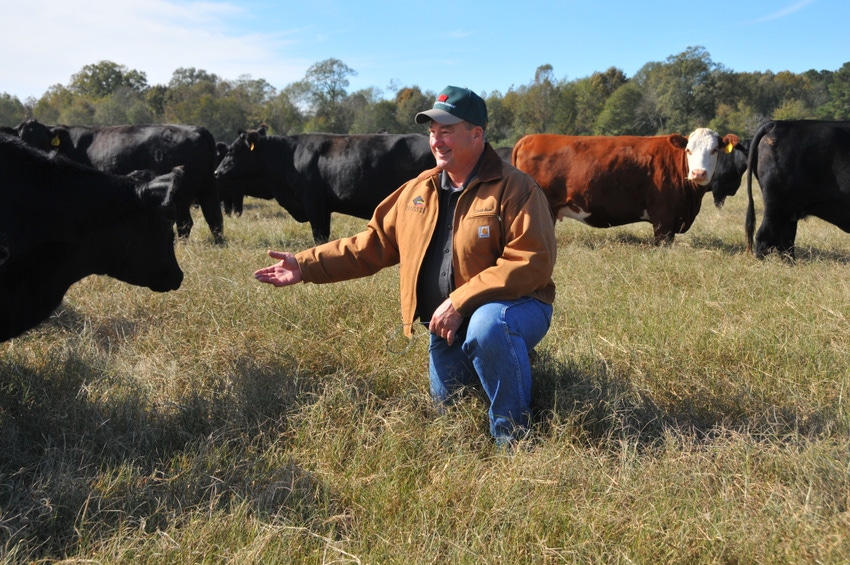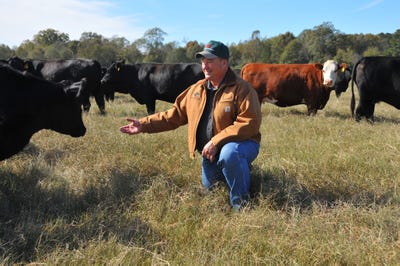Stockpiled bermudagrass is like a barn without a roof, Price Wallace says. But it saves time and harvest expense.
June 23, 2014

When Price Wallace came back into the cattle business, he knew he couldn’t just do things the way his late father had done.
Times change. Economics change. And the business of their River Birch Farm near Mendenhall, MS, had changed. All of that affects how Wallace grows forage and feeds cattle.
Wallace also operates chicken houses on the farm. That enterprise takes time, but it complements his cow-calf business. It generates litter he uses to increase the fertility of the bahiagrass pastures and hay fields.
With that fertility, he can grow more grass or he can grow more weeds. “Whatever is there will grow,” Wallace says. Unless suppressed, weeds always seem to get a jump on the grass. So, not wanting to waste fertility, he’s made weed control a priority.
“My cows won’t eat a weed, and I’m not a goat farmer. I make more money when my cows have good forage,” Wallace says.
Spray more, mow less

Willing to try something new, Price Wallace sprays weeds and stockpiles bermudagrass to save money and make better use of time.
“My daddy probably bush hogged three times a year. But I learned I could control my pastures better and produce more forage with spraying than with a bush hog,” he continues.
A rotary mower is handy to have when you start work on a pasture, Wallace says. But now he seldom hooks up to either of the two he owns.
“I saw how easy it was to spray and the time it afforded me to do other things. I can spray that quick,” he says, snapping his fingers. “It depends on how you value your time.”
When his time is really tight, Wallace has had his herbicide custom-applied by his supplier, Agri-AFC in Hattiesburg, MS.
Timing for targets
Depending on weather and weed pressure, Wallace has sprayed some pastures twice in the same year. When winter weeds are a problem, and if pastures aren’t too wet, he’ll spray in February and early March with 2,4-D. That will take out the buttercup. For tougher summer weeds like horsenettle and pigweed, he turns to a later application of GrazonNext® HL herbicide at the labeled rate of 1.5 pints per acre.
“I’ll spray GrazonNext HL at the end of April to first of June, and pastures stay clean until August when pigweed starts coming in,” Wallace says.
Pigweed is a special problem because of its ability to germinate almost anytime over a six-month period. Control one crop, and there’s another ready to germinate in the soil until that seed bank is exhausted.
Residual activity helps
The soil residual activity of GrazonNext HL helps by controlling new seedlings that emerge for a time after spraying. But, soil residual doesn’t last forever.
“There’s just so much seed,” Wallace says. “Overall, though, once you kind of get control of weeds, it’s pretty easy to maintain.”
Horsenettle was once a problem, but it’s been easier to control than pigweed. “I hadn’t found anything that will really zap it until GrazonNext HL,” Wallace says. “It really controls horsenettle.”
That’s important, especially for making hay, whether for himself or for sale. Wallace is a stickler for clean, quality hay, and it shows in the analysis. A customer’s test of Wallace’s hay indicated 12 percent crude protein and 57 percent total digestible nutrients (TDN).
More grazing, less haying
Making hay, though, is one of the things that may be changing in Wallace’s operation. Last year, he experimented with stockpiling a bermudagrass hayfield in the fall. He then limit-grazed it to delay the start of hay feeding.
Instead of taking a fourth cutting, he allowed the grass to grow until November 1 when 55 cows gained access to the 10-acre field. “I turned cows in the morning and pushed them out at night,” Wallace says. Water and mineral were outside the hayfield, so cows grazed the hayfield more than camping on it.
“Basically it’s like having a barn with no roof on it,” Wallace says. “It’s doing what I want it to do – put off feeding hay until the middle of December. And I didn’t have to spend $20 per bale to make bales.”
Practices may have changed, but Wallace’s father would have approved of making or saving a buck.
Label precautions apply to forage treated with GrazonNext HL and to manure from animals that have consumed treated forage within the last three days. Consult the label for full details.
®Trademark of The Dow Chemical Company (“Dow”) or an affiliated company of Dow.
Grazon P+D is a federally Restricted Use Pesticide.
GrazonNext HL is not registered for sale or use in all states. Contact your state pesticide regulatory agency to determine if a product is registered for sale or use in your state
Always read and follow label directions.
Other trending stories in pasture management:
Quick Steps To Help Pastures Recover From Drought
6 Tips For Cost-Effective Weed Control
What Is Good Grazing Management?
How To Prevent Death Loss From Toxic Weeds
Which Thistle Do You Spray For Best Return On Investment?
About the Author(s)
You May Also Like



